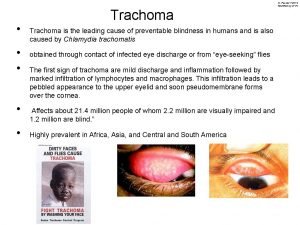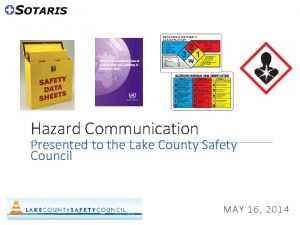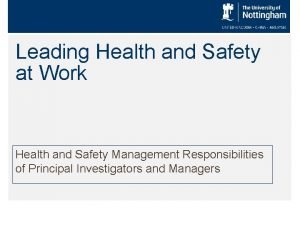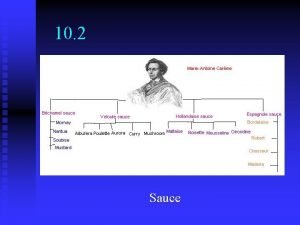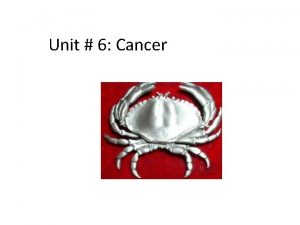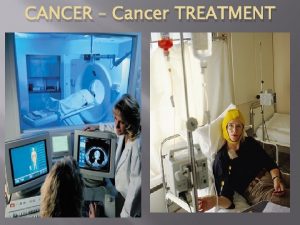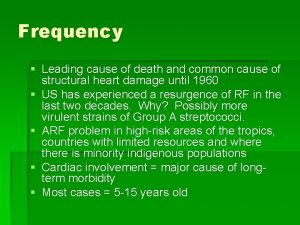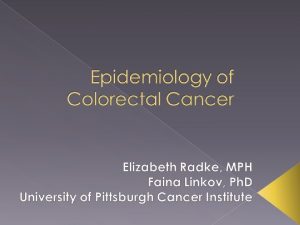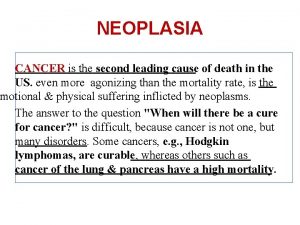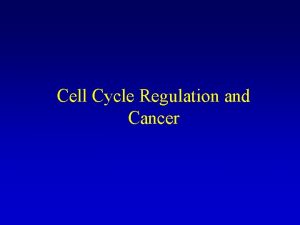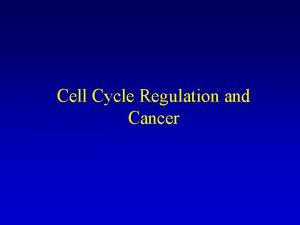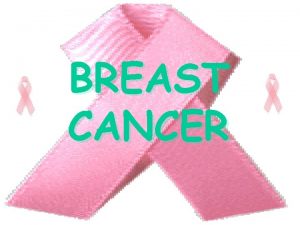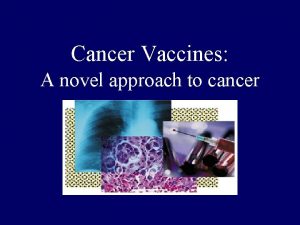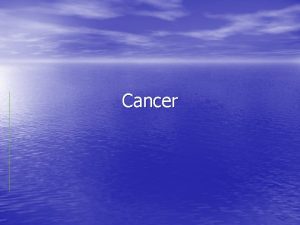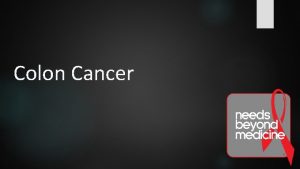Unit 6 Cancer Overview 2 nd leading cause






















































- Slides: 54

Unit # 6: Cancer

Overview • • 2 nd leading cause of death in Canada 29% of all mortality (2004) Higher risk in people over 65, males Leading cause of Potential Years of Life Lost (PYLL) – Ex. PYLL • A man who has a life expectancy of 70 dies at age 65 from cancer, his PYLL = 70 -65 = 5

New cases (A) and Deaths (B) by cancer type in Males A B

New cases (A) and Deaths (B) by cancer type in Females A B

Incidence (A) and Mortality (B) rates by age A B

Incidence (bars) and Mortality rates (line) for males (A) and females (B) A B

Worldwide Trends • Accounted for 7. 4 million worldwide deaths (2004) • Expected to rise to 12 million by 2030 • Leading mortal cancers by gender: – Men: lung, stomach, liver, oesophageal, prostate – Women: breast, lung, stomach, colorectal, cervical

Mechanism of cancer: How does it happen? • Normal, healthy cells have genes which control: • When they divide • When they stop dividing • When they die • Repetitive exposure to certain agents can cause an accumulation of mutations in these genes, and they lose this control • Cancer is a disease evidenced by: uncontrolled cell growth and spread

Mechanism of cancer The mutations that result in cancer are caused by: Carcinogens: cancer causing agent Physical carcinogens: UV light, radiation Chemical Carcinogens: asbestos, chemical in tobacco smoke, arsenic Biological carcinogens: viruses, bacteria, parasites

Development of Cancer: “Multiple hits” finally lead to a genetic change

Main Genes Responsible for Cancer • Proto-oncogens/oncogenes • Proto-oncogenes regulate – how often a cell divides – how specialized it is (able to perform a particular task) • A mutation turns proto-oncogenes into oncogenes and the cell no longer has regulated control over division • Summary: oncogenes are cancer ________ genes and they are turned ______

Main Genes Responsible for Cancer • Tumour Suppressor Genes – normally function to suppress cancerous growth by: • Suppressing uncontrolled growth • Repairing DNA mutations • Telling the cell when to die – Mutations can turn these genes off • Summary: TSG’s are cancer _______ genes, they are turned ____

Neoplasms • Neoplasms are new growths in the body. They occur constantly. These growths can form a dense group of cells called a ___________. Not all tumours are cancerous! • Benign tumours are growths which are enclosed in a membrane. • • Still have control over growth Do not invade Do not metastasize (spread) NOT CANCER!!! • Malignant tumours are cancerous growths which are not enclosed in a membrane • • No control over cellular growth Invade Metastasize CANCER!!!

Metastatic tumours (Cancer)

Benign vs. Malignant tumour

Cancer Staging • Overall Stage Grouping – Stage 0: a growth that stays in place, no metastasis, no invasion – Stage 1: cancer localized to one area – Stage 2: cancer is localized to one area, but is more aggressive – Stage 3: invasion into local areas and/or lymph nodes – Stage 4: Metastatic cancer

Cancer Staging ex. Prostate Cancer

Survival Rate • Cancer is considered cured if patient lives five years after original diagnosis – Varies with the type of cancer. • Ex. High with skin cancer, low with brain cancer • Survival rate increases with EARLY DETECTION! • However, cancer can have a very long latent period – latent period = time between first exposure to a carcinogen (ex. Cigarette smoke) and the first signs and symptoms showing (ex. Lung cancer)

Cancer Treatment in General • Surgery • Radiation • Chemotherapy (drugs)

Cancer Treatment • Cancer treatment is tailored to the individual. Each case is different. • A team of doctors will consider the: type, stage, general health, medical problems of the patient • Will decide on the best course of action for that specific patient • Health Care spending for cancer treatment is a huge burden on both the health care system and the patient/their supporters



MAJOR TYPES OF CANCER

Male incidence rates for different cancers

Male mortality rates for different cancers

Female incidence rates for different cancers

Female mortality rates for different cancers

Lung Cancer • Highest mortality rate of any cancer • Rates are actually increasing in Canadian females

Lung Cancer Risk Factors • Smoking is the leading risk factor – Smokers are 10 -20 times more likely to get lung cancer than non-smoking population • • • Asbestos Arsenic Exposure to Radon Gas Family history Previous case of lung cancer Air pollution

Smoking and Lung Cancer

Lung Cancer • Symptoms: chronic cough that worsens, breathing problems, chronic chest pain, hoarse voice • 5 -year survival rate: 13% (males); 17% (females) • Screening: No effective screening exists!

Breast Cancer

Female Age-standardized incidence rates for breast cancer Female Age-standardized mortality rates for breast cancer What does this suggest? ? ?

Breast cancer risk factors • Females are at much higher risk • Males = less than 1% • • Previous breast cancer Family history of ovarian cancer Above average estrogen exposure (promotes cancerous growth!) • Early menstruation and late menopause • Never given birth, first child after 60 • Older Age • Also: obesity, alcohol, birth control pills may slightly increase your risk

Breast Cancer • Signs and symptoms: lump, changes in breast size/shape, dimpling, puckering of skin, redness, inverted nipple • 5 -year survival rate: 84% (women); 87% (men) • Screening: multi-stage screening; highly effective!

Breast Cancer Screening • Breast self-examination • Mammography a low dose breast X-ray • Multi-stage screening: – Involves an initial general screening test, then subsequent diagnostic tests become more and more specific – Note: screening is done on healthy populations, testing is done on people who already have the disease

Multi-level screening

Prostate Cancer

Prostate cancer risk factors • • Age Family history African ancestry Also: obesity, physical inactivity, high fat diet, very excessive calcium intake may slightly increase risk (all are currently being studied more)

Prostate cancer • Signs and symptoms: frequent/urgent urination, difficulty with the control of urine flow, inability to urinate, burning/pain urinating, painful ejaculation. – Often NO symptoms are evident! Extremely important to SCREEN!!! Do not ignore any of the above symptoms! • 5 -year survival rate: 95% with early detection • Screening: PSA test, digital rectal exam

Colorectal Cancer

Colorectal cancer risk factors • Age (50+) • Appearance of polyps (small growth on inner wall of colon/rectum) • Family history • Inflammatory bowel diseases • Diet high in red meat, processed meat, alcohol • Smoking • Physical inactivity • Obesity • Diet low in vegetables and fruits, fibre

Colorectal Cancer • Signs and symptoms: change in bowel movements, blood in stool, diarrhea, constipation, narrow stools, abdominal pain, unexplained weight loss • 5 -year survival rate: 61% (males), 62% (women) • Screening: People over 50 are recommended to have a fecal occult blood test (FOBT) every 2 years minimum

Cervical Cancer

Cervical cancer risk factors • Infrequent Pap tests • Sexual activity (young, frequent, multiple partners) • Smoking • Weakened immune system • Long term use of birth control pills • Having many children

Cervical Cancer • Signs/symptoms: abnormal vaginal bleeding, bleeding between cycles, longer menstruation, increased vaginal discharge, pain in pelvis/during intercourse • Early detection: Pap test! Get it!

Skin Cancer Most commonly diagnosed cancer Easy to treat since it’s on the surface It rarely metastasizes Basal cell carcinoma= most common, easier to treat • Malignant melanoma= more aggressive, metastasizes • •

Skin cancer risk factors (melanoma) • • UV exposure (sunlight/tanning beds) Unusual moles Large amount of moles Light skin, eyes, hair Skin that burns/freckles easily History of melanoma Family history Severe sunburn during childhood

Skin cancer • Signs/symptoms: new/unusual looking skin growths, itchy moles, ABCD moles (see figure, next slide) • 5 -year survival rate: depends on the type of skin cancer/ when it is discovered. If skin cancer is discovered and treated before it spreads, survival rate close to 100%! • Early detection: look for the signs/symptoms of skin cancer, namely the change in appearance of moles

How to Spot Skin Cancer: ABCD

Blood Cancers • Not strongly correlated with increased age, affects young and old • There are many types of cancers that affect the blood. They are named for the type of blood tissue they affect: – Leukemia: affects leukocytes (white blood cells) – Lymphoma: affects lymphocytes (ie. B/T cells) – Myeloma: affects plasma cells (recall, become B cells)

Blood Cancers • Cause is unknown!!! • Signs/symptoms: not always obvious! May notice chronic fever, unexplained weight loss, tiredness, shortness of breath, bruising, bleeding, difficulty healing • 5 -year survival rate: varies greatly depending on age/ when detected! – 23. 4%(adults with acute myelogenous leukemia) – 90. 9% (children under 5 with acute lymphocytic leukemia) • Early detection: no effective screening, watch for signs/symptoms

Primary Prevention of Cancer Avoid the major risk factors! • • Tobacco use Overweight/obesity low fruit and vegetable intake Physical inactivity Alcohol use Chronic HPV infection Urban air pollution

5 gives you 50% • The BC Cancer agency stresses that changing just 5 main lifestyle behaviours reduces your risk of cancer by approximately 50%!!! – Smoking – Physical inactivity – Poor diet (fats, low fibre, high salt, high protein) – Sunlight exposure – Unhealthy weight
 Bobbin leading principle
Bobbin leading principle Leading cause of preventable blindness
Leading cause of preventable blindness Flame over circle symbol meaning
Flame over circle symbol meaning Underlying cause and immediate cause
Underlying cause and immediate cause Proximate cause and ultimate cause
Proximate cause and ultimate cause Proximate vs ultimate causation
Proximate vs ultimate causation Kinesis and taxis
Kinesis and taxis Writing an informal email
Writing an informal email Unit 10, unit 10 review tests, unit 10 general test
Unit 10, unit 10 review tests, unit 10 general test How to tell if leading coefficient is positive or negative
How to tell if leading coefficient is positive or negative What is a polynomial coefficient
What is a polynomial coefficient Liberty leading the people, 1830
Liberty leading the people, 1830 Troop leading steps
Troop leading steps Tlp army
Tlp army Troop leading procedures
Troop leading procedures Imperial motives
Imperial motives Ivory
Ivory Staffing and directing in management
Staffing and directing in management Leading age colorado
Leading age colorado Bernada dasar apa kokonorotomo
Bernada dasar apa kokonorotomo How to round decimals to the nearest hundredth
How to round decimals to the nearest hundredth Degree and leading coefficient
Degree and leading coefficient How to find end behavior of a function
How to find end behavior of a function What is the leading coefficient of a polynomial
What is the leading coefficient of a polynomial Leading coefficient of a graph
Leading coefficient of a graph Organizing staffing directing controlling
Organizing staffing directing controlling Leading strand and lagging strand
Leading strand and lagging strand Who are managers
Who are managers Power factor leading and lagging
Power factor leading and lagging Leading university sylhet tuition fees
Leading university sylhet tuition fees Kotter why transformation efforts fail
Kotter why transformation efforts fail What is the climax of act 3?
What is the climax of act 3? Leading above the line
Leading above the line Leading and working in teams
Leading and working in teams Chapter 5 principles of voice leading answers
Chapter 5 principles of voice leading answers Song leader hand signals
Song leader hand signals Liberty leading the people, 1830
Liberty leading the people, 1830 Troop leading procedures army
Troop leading procedures army Leading by convening
Leading by convening 5-3 polynomial functions
5-3 polynomial functions Leading coefficient quadratic equation
Leading coefficient quadratic equation Polynomial constant term
Polynomial constant term Leading coefficient test chart
Leading coefficient test chart Leading and kerning
Leading and kerning Principles of flight air cadets
Principles of flight air cadets How to write a polynomial in standard form
How to write a polynomial in standard form End behavior of a function
End behavior of a function What is a leading coefficient
What is a leading coefficient Leading health and safety at work
Leading health and safety at work Leading better value care
Leading better value care Leading better care
Leading better care Leading a healthy life chapter 1
Leading a healthy life chapter 1 Edging nnn
Edging nnn Leading sauce
Leading sauce Leading and outstanding
Leading and outstanding

